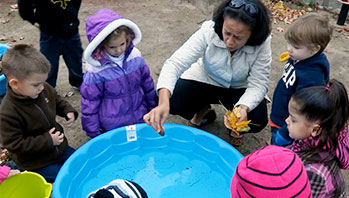- camera (optional)
- clipboards
- digging tool
- garden hose
- markers
- paper
- pen
- scissors
- sticks
- water containers (plastic buckets, squirt bottles, and cups)
- white stick tags
- yarn
- flow
- puddle
- stream
- river
MA Standards:
Language/L.PK.MA.6: Use words and phrases acquired through conversations, listening to books read aloud, activities, and play.
MA Draft STE Standards:
Earth and Space Sciences/Earth’s Systems/ESS2.A: Observe, investigate, and classify the non-living materials, natural and human made, in their environment.
Earth and Space Sciences/Earth’s Systems/ESS2.C: Explore and describe the different places water is found in the local environment.
Physical Sciences/Matter and Its Interactions: Structure and Properties of Matter/PS1.A: Describe, compare, sort and classify objects based on observable physical characteristics, uses, and whether it is manufactured as part of their classroom play and investigations of the natural and human-made world.
Head Start Outcomes:
Logic and Reasoning/Reasoning and Problem Solving: Classifies, compares, and contrasts objects, events, and experiences.
Science Knowledge/Conceptual Knowledge of Natural and Physical Worlds: Observes, describes, and discusses properties of materials and transformation of substances.
PreK Learning Guidelines:
English Language Arts/Language 2: Participate actively in discussions, listen to the ideas of others, and ask and answer relevant questions.
Science and Technology/Earth and Space Sciences 5: Compare and contrast natural materials such as water, rocks, soil, and living organisms using descriptive language.
Science and Technology/Physical Sciences 19: Explore, describe, and compare the properties of liquids and solids found in children's daily environment.
Explore Together (outdoors): Water Rivers

© Commonwealth of Massachusetts, Department of Early Education and Care (Jennifer Waddell photographer). All rights reserved.
STEM Key Concepts: Water flows downhill; Different objects can be used to move water and change its direction; Water behaves differently on different surfaces: it gets absorbed on some surfaces and not on others and it gets absorbed differently on different surfaces
ELA Focus Skills: Listening and Speaking, Vocabulary
Educator Prep: You may want to provide water smocks for children to help keep children dry (garbage bags with holes for head and arms work well). Review guidelines about splashing and squirting. Before the activity, go outside and identify an area with dirt that children can use for their explorations.
Safety Tips:
- Remind children to wash their hands before and after the activity.
- Be aware of and check for poison ivy, poison sumac, and thorny or prickly bushes before gathering children in a designated area.
Tell children they are going to go outside to continue to explore water and how it moves. Tell them that today they will make rivers and streams of flowing water, in the dirt and on other surfaces. Ask,
- Which do you think will work best for making the water flow like a river, a hose or a squirt bottle? Why do you think so?
Take children outside to the pre-designated area and gather them around it. Point out the digging tools and explain that today they will use the dirt surface for their explorations.
Encourage children to pour, squirt, and spray water, making puddles, or pools of water, in the dirt. Invite them to use the sticks and other digging materials to make the water flow and stream from the puddles.
Allow children to freely explore water flowing on different surfaces. Observe, listen to, and engage children as they investigate water flowing and streaming. Take photos and/or have children take photos to document their observations. Ask questions such as,
- How did you make that river/stream in the dirt?
- What could you do to make the water flow even farther on the dirt?
- What do you think will happen if you dig the path deeper?
- What if you spray a hose on the pavement and on the grass? Do you think the water will flow in the same way or in a different way?
Reflect and Share
Once inside, share the photos and have children share their observations. Ask questions such as,
- What were some of the ways you got the water to flow from the puddle?
- What way worked best to make rivers and streams?
- What tool did you use to make the water flow the farthest? Why do you think that made the water go farther?
- Did the water flow in a stream when you squirted it on the dirt with the squirt bottle? Why do you think so?
- What happened to the water you squirted on the pavement? What happened when you poured water from a bucket in the same place? Why do you think so?
